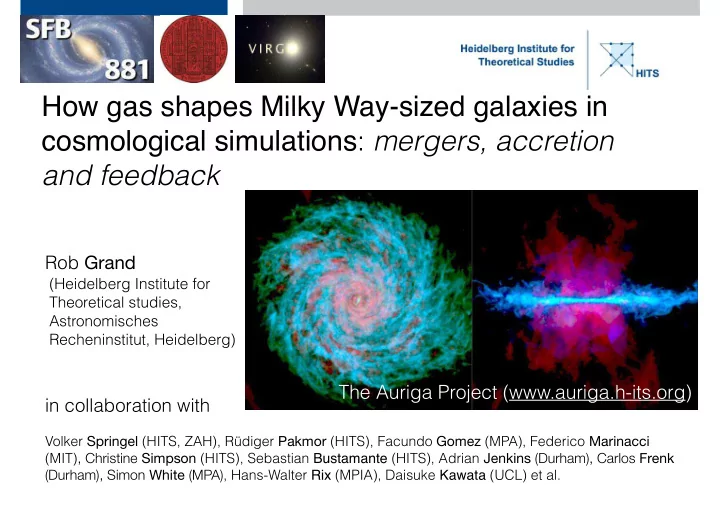

How gas shapes Milky Way-sized galaxies in cosmological simulations : mergers, accretion and feedback Rob Grand (Heidelberg Institute for Theoretical studies, Astronomisches Recheninstitut, Heidelberg) � � The Auriga Project (www.auriga.h-its.org) in collaboration with � Volker Springel (HITS, ZAH), Rüdiger Pakmor (HITS), Facundo Gomez (MPA), Federico Marinacci (MIT) , Christine Simpson (HITS), Sebastian Bustamante (HITS), Adrian Jenkins (Durham), Carlos Frenk (Durham), Simon White (MPA) , Hans-Walter Rix (MPIA), Daisuke Kawata (UCL) et al.
Aim: To produce a set of Milky Way mass haloes that: • is high-resolution and large in number � • follows a comprehensive galaxy formation model capable of producing realistic galaxy populations … that produces disc-dominated, late-type, star-forming spirals…
The Auriga Project: Cosmological zoom MW mass halo simulations (Grand+ 2017) • 5x10 11 < M vir (z=0) < 2x10 12 AREPO - moving mesh MHD code (Springel 2010) • 40 sims @ standard res: • Star formation � • SNII feedback � • Reioinisation (z=6) � • Black hole growth � star mass res ~10^4 Msun - • Metal line cooling � • Radio & quasar grav softening ~ 300pc (optimal) - • Mass & metal enrich. AGN feedback � • 6 sims @ hi-res (x8 mass, x2 spat) • Magnetic fields (Type Ia & AGB) movie @ http://auriga.h-its.org/movies.html
Scaling relations
A large sample of hi-res, rotationally supported star-forming MW analogues: Scaling relations Simulations evolve parallel to the stellar mass-halo mass abundance matching relation SFR vs. Mstar relation well reproduced over time
A large sample of hi-res, rotationally supported star-forming MW analogues: Scaling relations Simulations evolve parallel to the stellar mass-halo mass abundance matching relation SFR vs. Mstar relation well reproduced over time
A large sample of hi-res, rotationally supported star-forming MW analogues: Scaling relations Simulations evolve parallel to the stellar mass-halo mass abundance matching relation SFR vs. Mstar relation well reproduced over time
HI gas maps at redshift zero: � A variety of sizes but all flat, disc-like distributions with small holes Marinacci+17
HI gas properties (Marinacci+17 (data available: http://auriga.h-its.org/data)) � Mass distributions contrasted with Bluedisk (Wang+ 14), SPARC (Lelli+ 16) and other nearby galaxies surface density mass-size relation HI gas fraction R/R HI D HI [kpc] M star [M sol ] Empirical (Leroy+ 08) Theoretical (based on Gnedin+Kravtsov 2011) (dust-gas ratio) (Interstellar rad field)
Gas disc evolution
General evolution of Star-forming gas thick+compact thin+extended z=1 z=0.5 z=0 • Merger phase z ≳ 1 � • Smooth increase (decrease) in V rot ( 𝜏 ) after z=1. • Similar to ‘ disc settling ’ seen in DEEP2/SIGMA surveys of SF galaxies (Kassin+12, Simons+17)
What drives the gas disc evolution? Turbulent gas accretion? Pakmor+ 17 • Gas inflows highly turbulent at early times, and decays from z~1-2 (also important in build up of magnetic field strength) • Rotational energy begins to dominate thereafter, marking the phase of strong disc growth
What drives the gas disc evolution? Stellar feedback driven fountain flows? Marinacci+17 fountain flows push gas outside mid plane • Present day gas-disc scale heights correlate with SFR declining SFR from z~2 —> naturally ‘deflating’ disc? • Scatter indicates other drivers, e.g., mergers…
What determines the radial disc size? Spin The diversity in disc size (R d ~1-10 kpc) correlates with spin Strong AGN feedback —> bears out expectations of z=0 companion halo collapse models (outlier) 1. late-time, violent, � (e.g., Peebles 69, Mo+ 98) major mergers
Drivers of disc growth: Spin The diversity in disc size (R d ~1-10 kpc) correlates with spin 2. prograde, � quiescent mergers Strong AGN feedback —> bears out expectations of z=0 companion halo collapse models (outlier) 1. late-time, violent, � (e.g., Peebles 69, Mo+ 98) major mergers
2. The Biggest discs: high-spins from in spiralling mergers accretion of stripped, high-Lz gas from gas-rich mergers builds biggest discs
Drivers of disc growth: Spin The diversity in disc size (R d ~1-10 kpc) correlates with spin 3. intermediate region � • mix of 1+2 • quiescent history… —> inherently have { these spins 2. prograde, � quiescent mergers Strong AGN feedback —> bears out expectations of z=0 companion halo collapse models (outlier) 1. late-time, violent, � (e.g., Peebles 69, Mo+ 98) major mergers
Late time Gas-rich minor mergers as a gas supply (Grand+17b) Violent, early phase disc growth phase begins stalls resumes Gas supplied by gas-rich merger � (disc growth resumes) Suggestive of cold-mode accretion at late times Gas inflow rate is low � and SF consumes gas at disc edge
Summary Galaxies match a range of observations and scaling relations * on the � scales we care about* � • stellar halo mass relation, SFH, rotation curves (Grand+17) • HI gas distributions (Marinacci+ 17) Star-forming gas disc ‘settles’ into extended, disc dominated � systems � • Turbulent accretion decays from z~1-2, then rotation dominated • Fountain flows may also play a role Wide range of disc sizes driven by: � • Quiescent mergers (biggest discs) • Violent mergers (small discs) Gas-rich minor mergers can be source of late-time cold-mode accretion
Recommend
More recommend